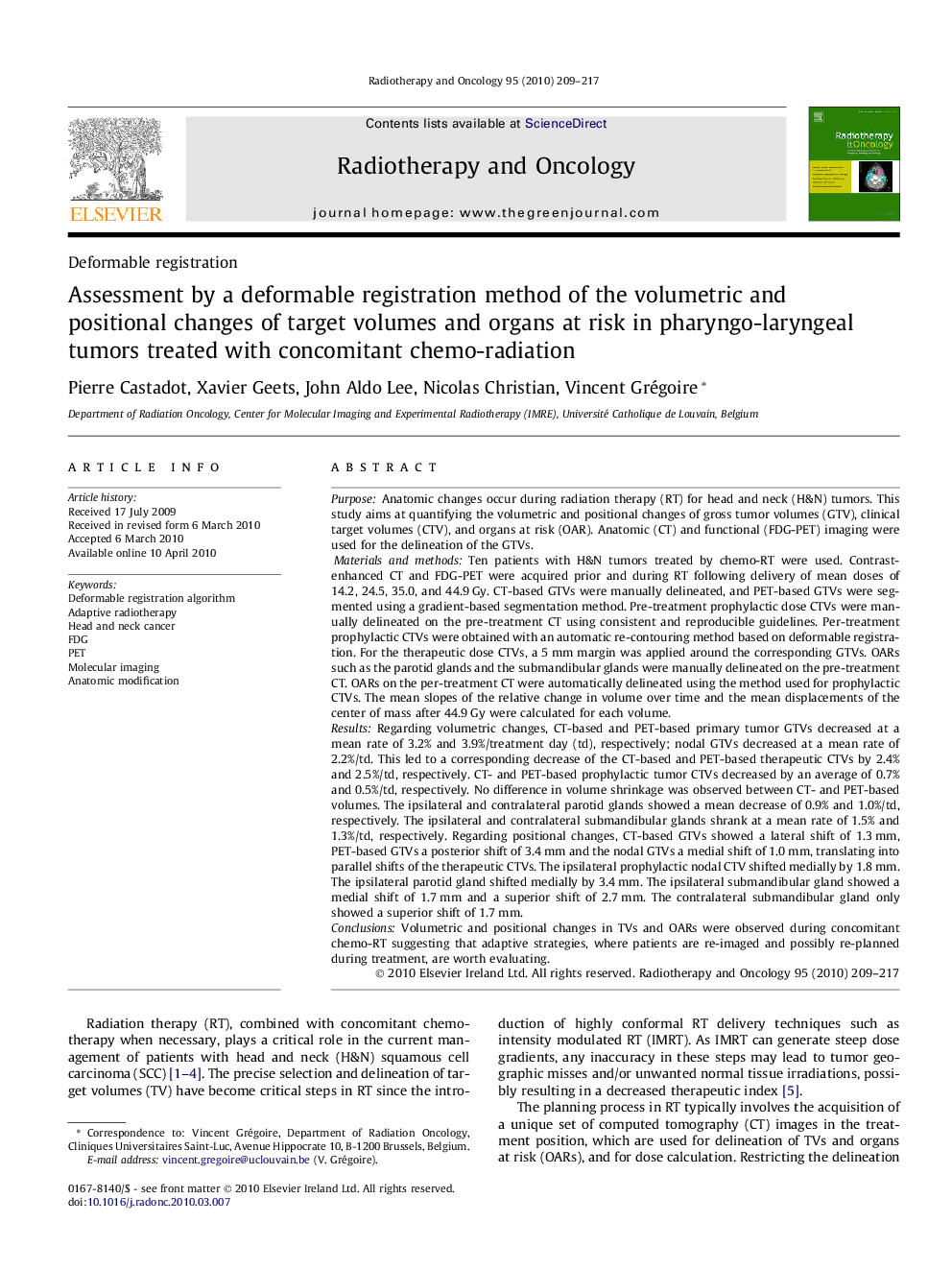| Article ID | Journal | Published Year | Pages | File Type |
|---|---|---|---|---|
| 2159409 | Radiotherapy and Oncology | 2010 | 9 Pages |
PurposeAnatomic changes occur during radiation therapy (RT) for head and neck (H&N) tumors. This study aims at quantifying the volumetric and positional changes of gross tumor volumes (GTV), clinical target volumes (CTV), and organs at risk (OAR). Anatomic (CT) and functional (FDG-PET) imaging were used for the delineation of the GTVs.Materials and methodsTen patients with H&N tumors treated by chemo-RT were used. Contrast-enhanced CT and FDG-PET were acquired prior and during RT following delivery of mean doses of 14.2, 24.5, 35.0, and 44.9 Gy. CT-based GTVs were manually delineated, and PET-based GTVs were segmented using a gradient-based segmentation method. Pre-treatment prophylactic dose CTVs were manually delineated on the pre-treatment CT using consistent and reproducible guidelines. Per-treatment prophylactic CTVs were obtained with an automatic re-contouring method based on deformable registration. For the therapeutic dose CTVs, a 5 mm margin was applied around the corresponding GTVs. OARs such as the parotid glands and the submandibular glands were manually delineated on the pre-treatment CT. OARs on the per-treatment CT were automatically delineated using the method used for prophylactic CTVs. The mean slopes of the relative change in volume over time and the mean displacements of the center of mass after 44.9 Gy were calculated for each volume.ResultsRegarding volumetric changes, CT-based and PET-based primary tumor GTVs decreased at a mean rate of 3.2% and 3.9%/treatment day (td), respectively; nodal GTVs decreased at a mean rate of 2.2%/td. This led to a corresponding decrease of the CT-based and PET-based therapeutic CTVs by 2.4% and 2.5%/td, respectively. CT- and PET-based prophylactic tumor CTVs decreased by an average of 0.7% and 0.5%/td, respectively. No difference in volume shrinkage was observed between CT- and PET-based volumes. The ipsilateral and contralateral parotid glands showed a mean decrease of 0.9% and 1.0%/td, respectively. The ipsilateral and contralateral submandibular glands shrank at a mean rate of 1.5% and 1.3%/td, respectively. Regarding positional changes, CT-based GTVs showed a lateral shift of 1.3 mm, PET-based GTVs a posterior shift of 3.4 mm and the nodal GTVs a medial shift of 1.0 mm, translating into parallel shifts of the therapeutic CTVs. The ipsilateral prophylactic nodal CTV shifted medially by 1.8 mm. The ipsilateral parotid gland shifted medially by 3.4 mm. The ipsilateral submandibular gland showed a medial shift of 1.7 mm and a superior shift of 2.7 mm. The contralateral submandibular gland only showed a superior shift of 1.7 mm.ConclusionsVolumetric and positional changes in TVs and OARs were observed during concomitant chemo-RT suggesting that adaptive strategies, where patients are re-imaged and possibly re-planned during treatment, are worth evaluating.
